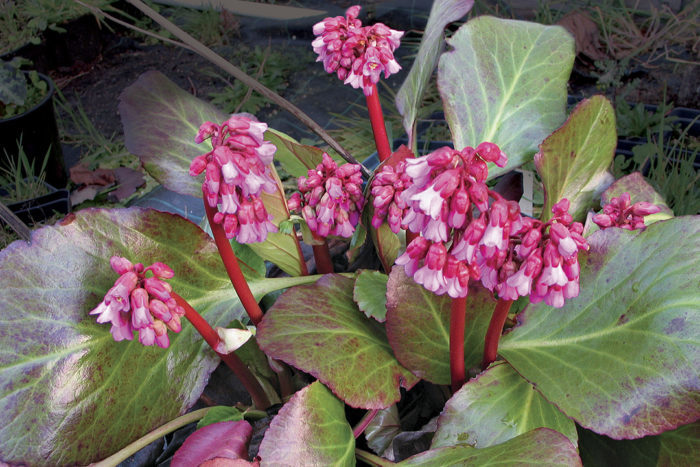
Perennials play such a pivotal part in the garden, bringing flow and floral dialogue to the design narrative. Then winter closes the book on the season, leaving bare ground where those showy summer peacocks slumber, and you strive to celebrate the beauty of the few gaunt skeletal remains for the next 4 or 5 months. We love the changing seasons and the dynamism of birth, growth, and senescence, and we also enjoy seeing the bare soil of a well-tended garden in winter—perhaps more often from envy. But as winter drags on, it is the evergreen perennials that keep the garden (and gardener) stable.
It has nice blooms, but the leaves are better
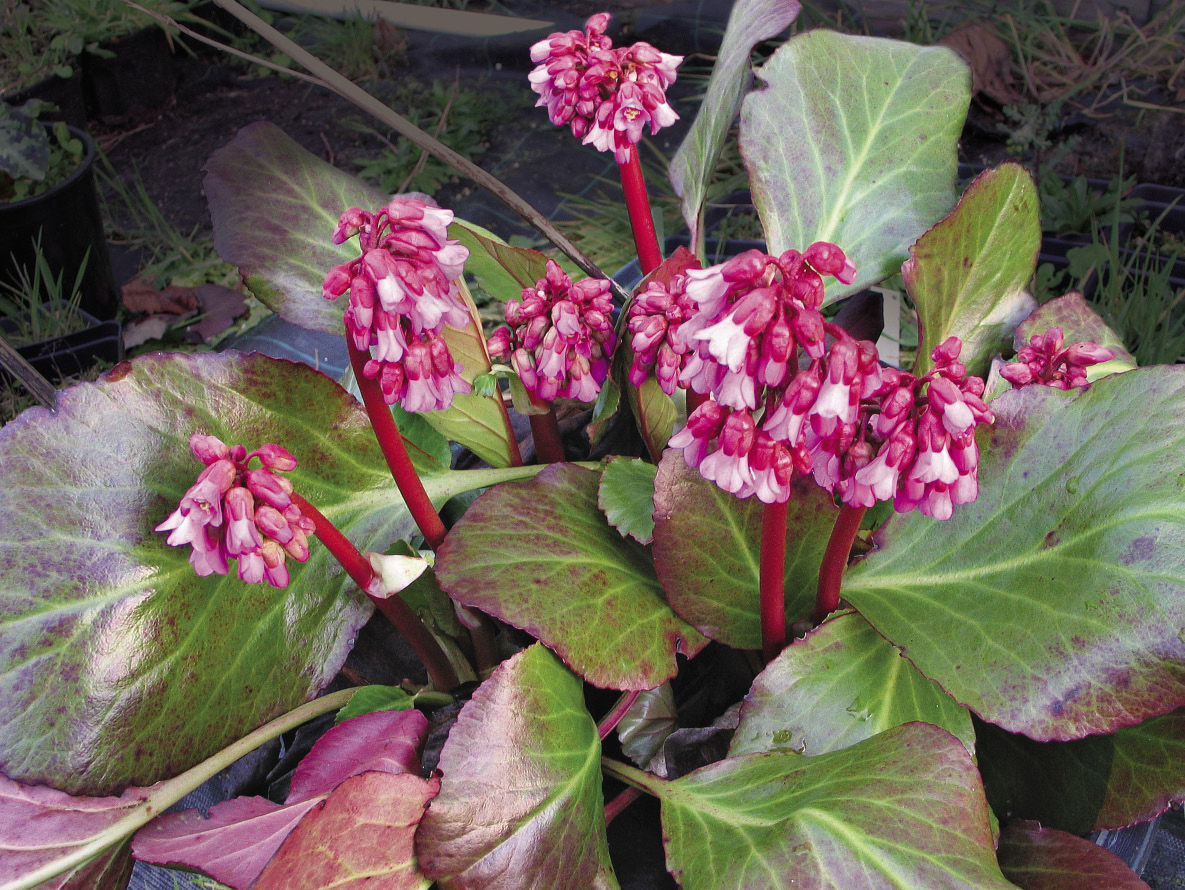
Name: ‘Eric Smith’ bergenia (Bergenia ‘Eric Smith’)
‘Eric Smith’ bergenia is one of the few reasons we look forward to winter. It’s a phenomenal workhorse and commemorates one of Britain’s great plantsmen and characters. Eric would be a first-round inductee to the Horticulture Hall of Fame if there were one thanks to his plant-breeding prowess. Beth Chatto introduced this bergenia in the 1970s, naming it for the extraordinary gardening personality who raised it. The flowers are excellent—a near-neon, hot harlot pink; but oddly, it is the foliage to which the memory returns. Sizable leaves of substance take on a serious purple-mahogany-chocolate cast in winter that places this plant squarely among the first rank of winter-interest ornamentals.
Zones: 5–9
Size: 18 inches tall and 28 inches wide
Conditions: Full sun to shade; moist, well-drained soil
The perfect plant to welcome spring
Name: Lazistan Black Sea iris (Iris lazica)
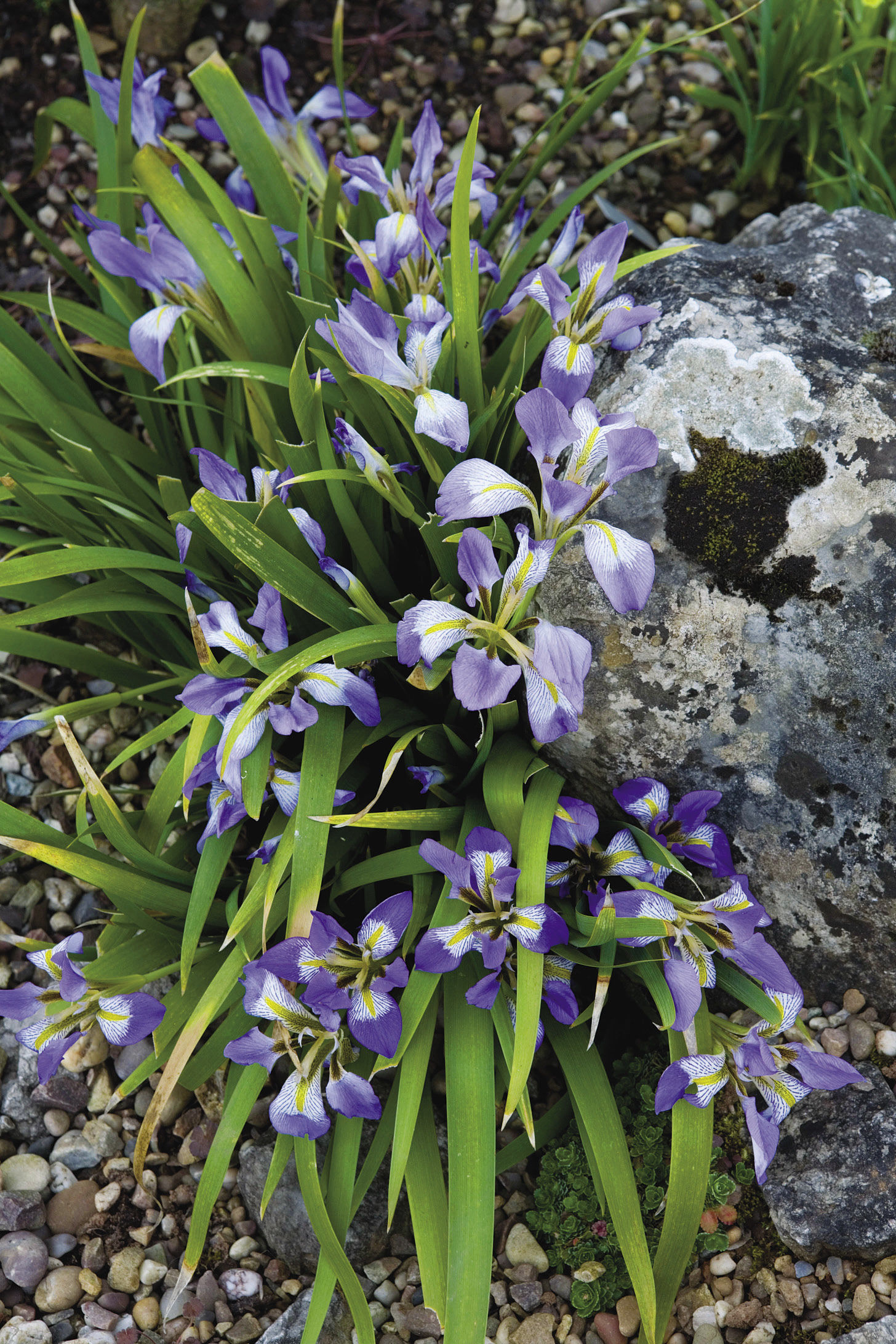
Lazistan Black Sea iris is notable for its winter-to-early-spring flowers in certain climates. Although it can tease with an odd flower in late fall or sporadically during winter warmups for us, the main flowering happens in early spring, coinciding with hellebores (Helleborus spp. and cvs., Zones 4–9) and early trillium (Trillium spp. and cvs., Zones 4–9). The light to dark violet-blue flowers have a yellow stripe bisecting a feathered white field, which is dotted in an indecipherable Morse code of blue dots and dashes. The blooms are held low near the base of the 2-foot-tall leaves and are best viewed when the plant is sited on a slope or in a raised bed. The evergreen foliage is superior to its better-known cousin, Algerian iris (Iris unguicularis, Zones 7–9). We grow this near the entrance to our propagation greenhouse so that we never get SAD (seasonal affective disorder) at work.
Zones: 7–9
Size: 2 feet tall and wide
Conditions: Partial shade; well-drained soil
Ever-present leaves set the stage for fragrant flowers
Name: Chinese ypsilandra (Ypsilandra thibetica)
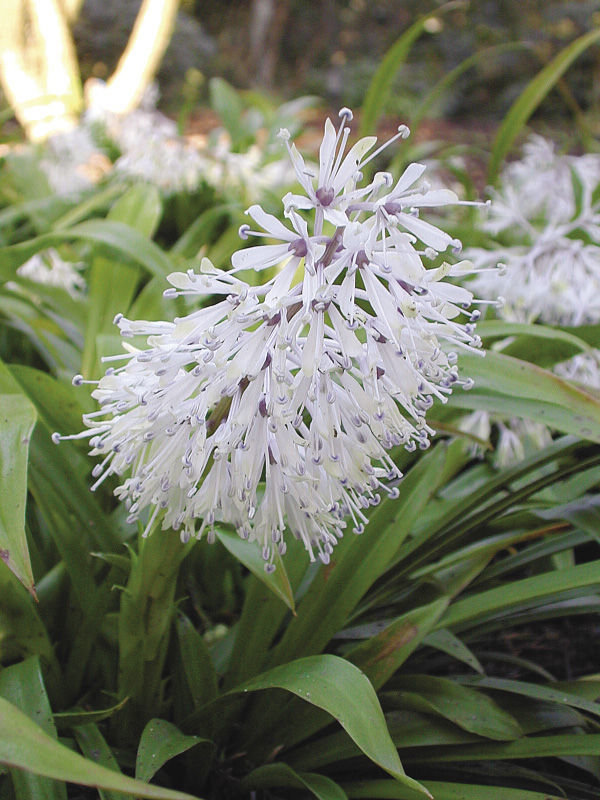
Flowering at the same time as Lazistan Black Sea iris is a related pair of collectors’ plants deserving of wider recognition. Chinese ypsilandra is a favorite, and not just because it is one of the few plants whose name starts with three unlikely consonants. This Chinese species is fairly new to the scene, notably from a Steve Hootman introduction in 1995. If you can grow a trillium, you can grow this plant, as they need similar conditions and are in the same family. From a rosette of evergreen leaves in early spring arise 15-inch-tall flower stems carrying white blooms that are lightly vanilla scented. We have seen this in China growing on moist, shaded rock faces deeply clad in moss. It has been a happy immigrant to our shade garden, where it enjoys a loose soil that’s high in organic matter.
Zones: 6–9
Size: 12-15 inches tall and wide
Conditions: Partial to full shade; rich, moist, well-drained soil
It’s not a lily, but it’s just as showy
Name: Oriental swamp pink (Heloniopsis orientalis)
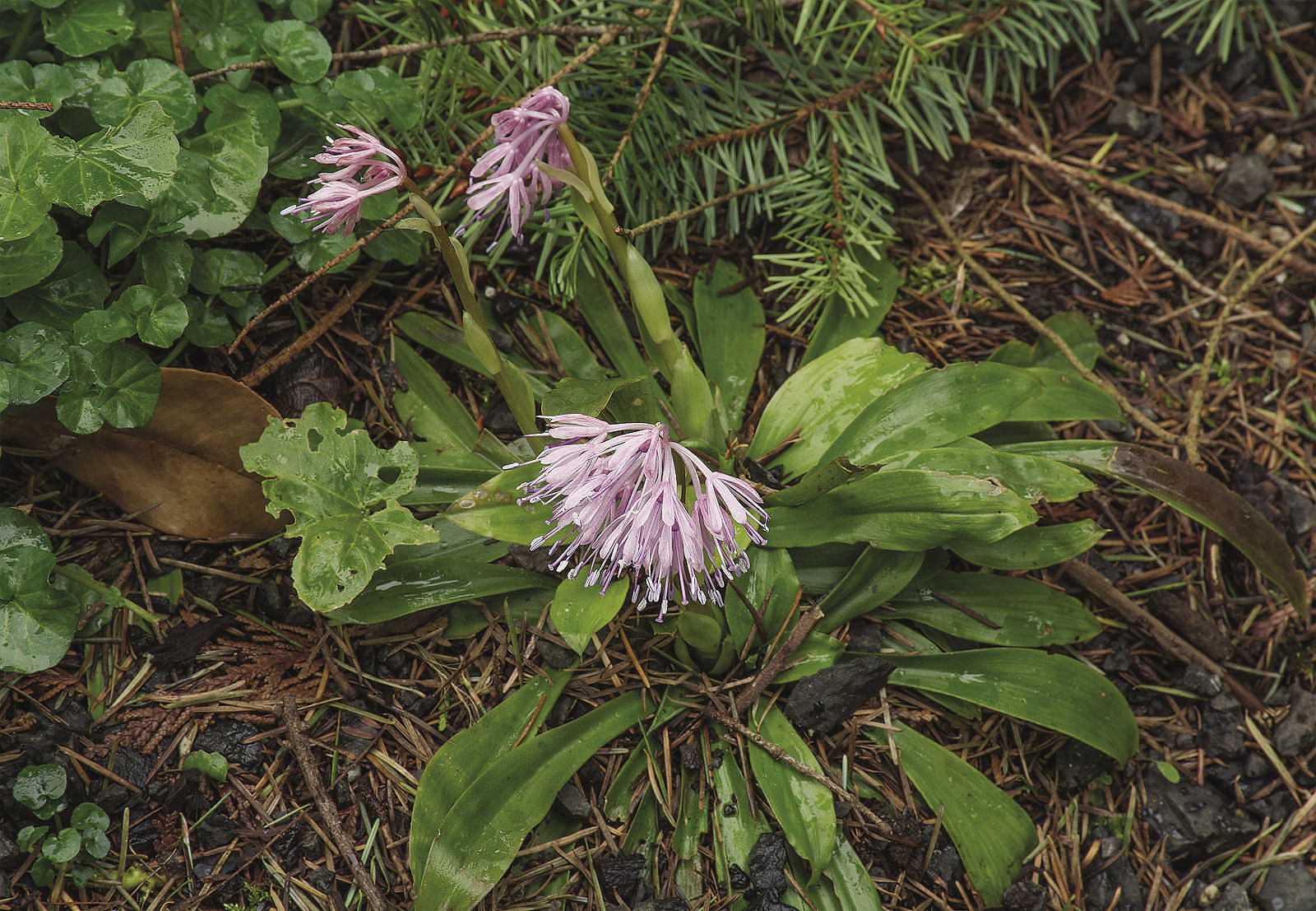
A close cousin to the Chinese ypsilandra is the Oriental swamp pink, which requires identical conditions. Small rosettes of narrow, lily-like leaves generally stay close to the ground, getting only 3 inches tall. A provocatively tumescent, overwintering flower bud in the center promises that you will feel the earth move come spring. This plant puts on a show that belies its size. Pink-lavender stars on a lollipop stick in early spring do not suffer by comparison amid the rush of spring flowers, as they look like nothing else. If you have OCCD (obsessive-compulsive collecting disorder), the legal department insists on the cautionary caveat that this is a gateway plant to not only other varieties and species, but different color forms, double-flowered forms, striped-leaf forms, and even a gold-leaf form. The latter is unstable, difficult, and expensive, and you should consider it an indicator plant of deeper issues if you manage to acquire it.
Zones: 5–8
Size: 3 inches tall and 10 to 12 inches wide
Conditions: Partial to full shade; rich, moist, well-drained soil
A loosestrife that won’t take over
Name: Chinese loosestrife (Lysimachia paridiformis var. stenophylla)
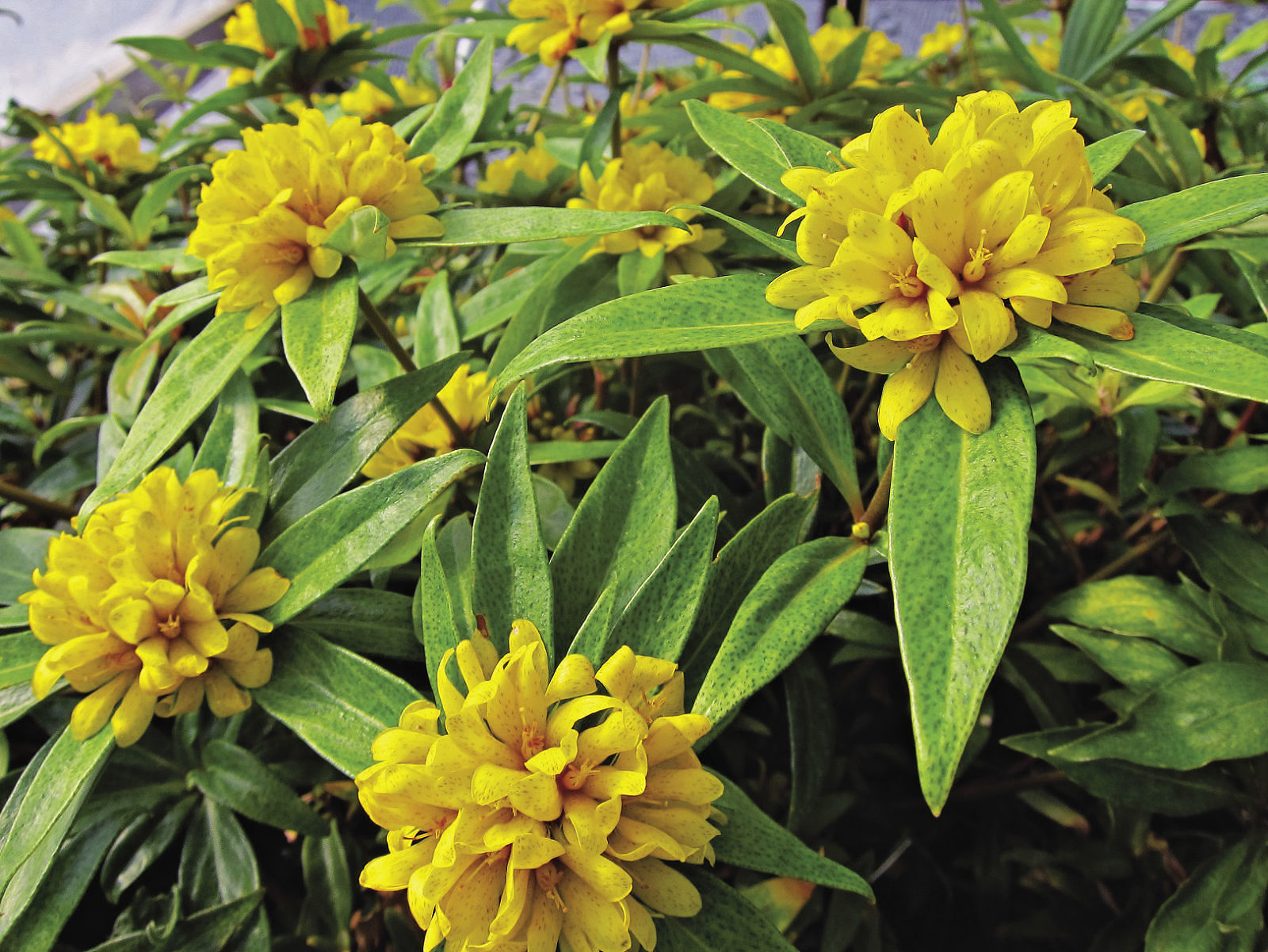
Mention “lysimachia” and our minds conjure either the lovely gooseneck loosestrife (Lysimachia clethroides, Zones 3–8) gobbling garden territory at a pace equivalent to the Mongol hordes subsuming Asia and Europe in the 13th century. Or we may think of the classic golden creeping Jenny (Lysimachia nummularia ‘Aurea’, Zones 3–9) spilling down the front of a container. Happily, there is a new sheriff in town, and, in keeping with shifting global dynamics, it is the Chinese loosestrife. First introduced into cultivation back in the 1980s from seed collected in China, this is a law-abiding, respectful clumper. Stems of whorled, narrow (the English translation of the Latin stenophyllous is “narrow”), evergreen leaves in a green corona surround a prominent central boss of yellow flowers in midsummer. More recent collections, such as the one we grow from Jens and Remy Nilsen, have been a huge improvement being at least twice as large in all parts (more than 18 inches tall and wide). This has taken the species from garden novelty to garden necessity, bringing much-needed summer color to moist shade gardens in a form and presentation that are unlikely to be echoed by other plants.
Zones: 6–9
Size: 12 to 18 inches tall and 24 inches wide
Conditions: Partial to full shade; moist soil
Bet you’ve never seen blooms like these
Name: Lamb’s tail (Umbilicus oppositifolium)
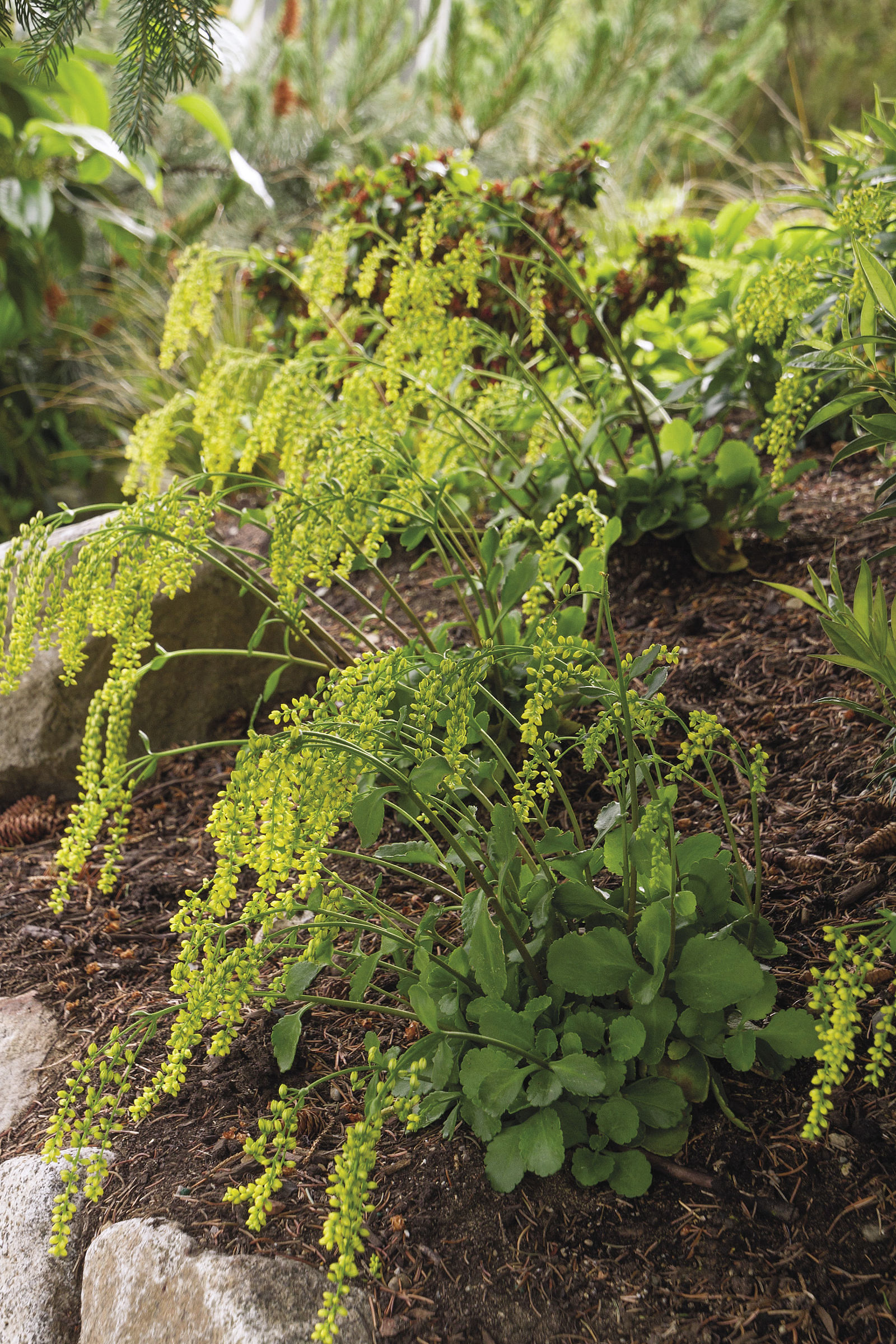
Lamb’s tail is native to the Caucasus Mountains, where it grows on shaded stony slopes. With its rounded, fleshy leaves, it is no surprise that it is in the Crassulaceae family along with sedums; and while it thrives in well-drained, moist soils, it seems quite happy in drier positions. It is a functional, relatively nondescript, small ground cover that quietly fills space—that is, until it flowers, and then it owns the joint with pendulous strings of golden, beadlike bloom-bling that has a universal appeal. (Lamb’s tail recently got the taxonomic boot, kicking it out of the genus Chiastophyllum thanks to DNA research, so many references may still have it listed under the old name.)
Zones: 6–9
Size: 18 inches tall and 24 inches wide
Conditions: Partial shade; well-drained soil
Its silver veining only increases its value
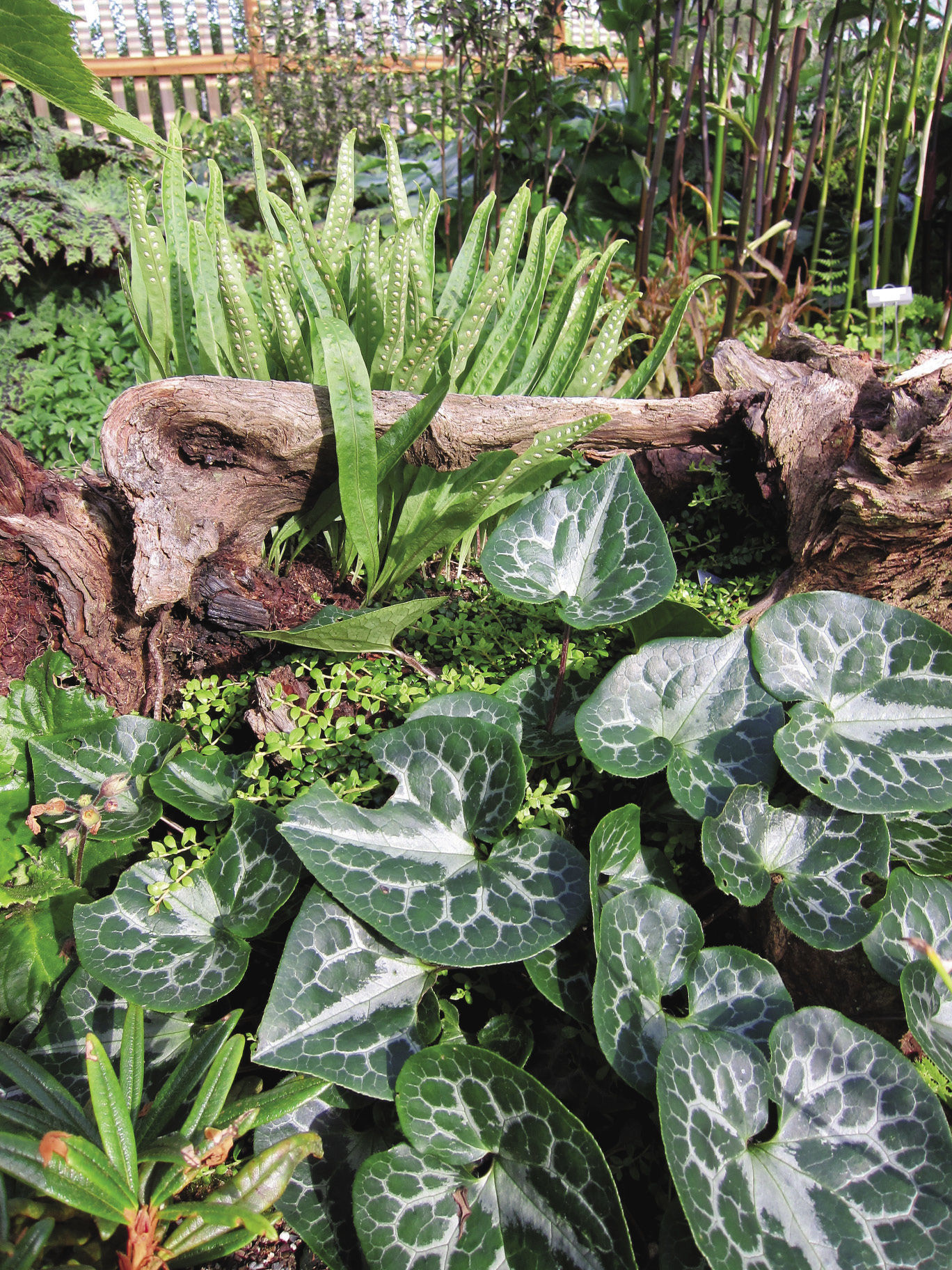
Name: Marbled wild ginger (Asarum marmoratum)
Zones: 5–9
Size: 4 to 8 inches tall and 10 to 16 inches wide
Conditions: Partial to full shade; moist soil
Wild gingers (Asarum spp. and cvs., Zones 2–9) are practically mandatory for shade gardens, and the southeastern United States can lay claim to having the showiest range of species in North America. But marbled wild ginger hails from southern Oregon and northern California, and its classy presentation matches up with the best of them. It does well in a variety of conditions, from partially shaded woodlands to surprisingly sunny rocky slopes. We grow ours in a light but moisture-retentive soil in shade, where it gives the best show of large, dark green, heart-shaped leaves patterned in white around a central white splash. Our usually voracious slugs prefer to munch on the Asian species over this pride of the West. It’s not commonly available, so the allure is only heightened by the thrill of the hunt.
The leaves sport a surprise below
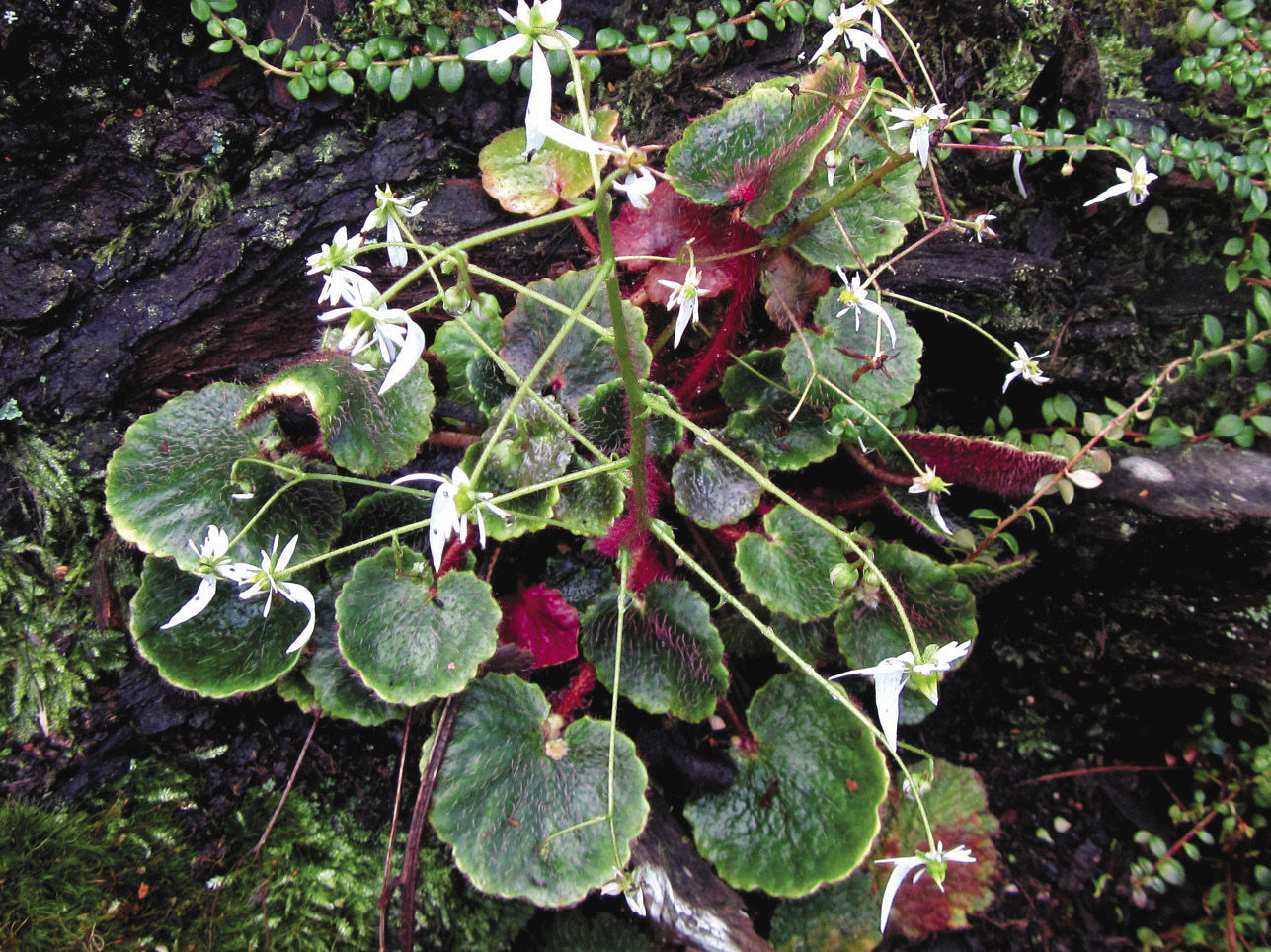
Name: ‘Jinfo Gem’ rockfoil (Saxifraga epiphylla ‘Jinfo Gem’)
Zones: 5–9
Size: 10 inches tall and wide
Conditions: Partial shade; moist soil
We collected seed of ‘Jinfo Gem’ rockfoil some years back from a shaded rock face on a mountain summit. This Chinese species was not formally recognized until 2000, so it is quite new to cultivation. The distinctive feature of this variety (which is great news for gardeners) is that it forms plantlets where the leaf blade joins the leaf stem, which is like cheating in propagation class. ‘Jinfo Gem’ rockfoil is essentially an alpine form of the species, with round medallions of smaller thickened leaves, dark green above and purplish red underneath. The new flower stems are bristling in red hairs and hold dainty white flowers like airy slices from a particularly nice snowflake. Any selection of the species you are lucky enough to acquire is well worth growing in cool, moist shade, but ‘Jinfo Gem’ is especially suited for that niche-garden bezel setting of stumpery, fern table, stone cleft, or path edge.
Deer don’t like it, but your driest spot will
Name: Kannah Creek® sulphur buckwheat (Eriogonum umbellatum var. aureum ‘Psdowns’)
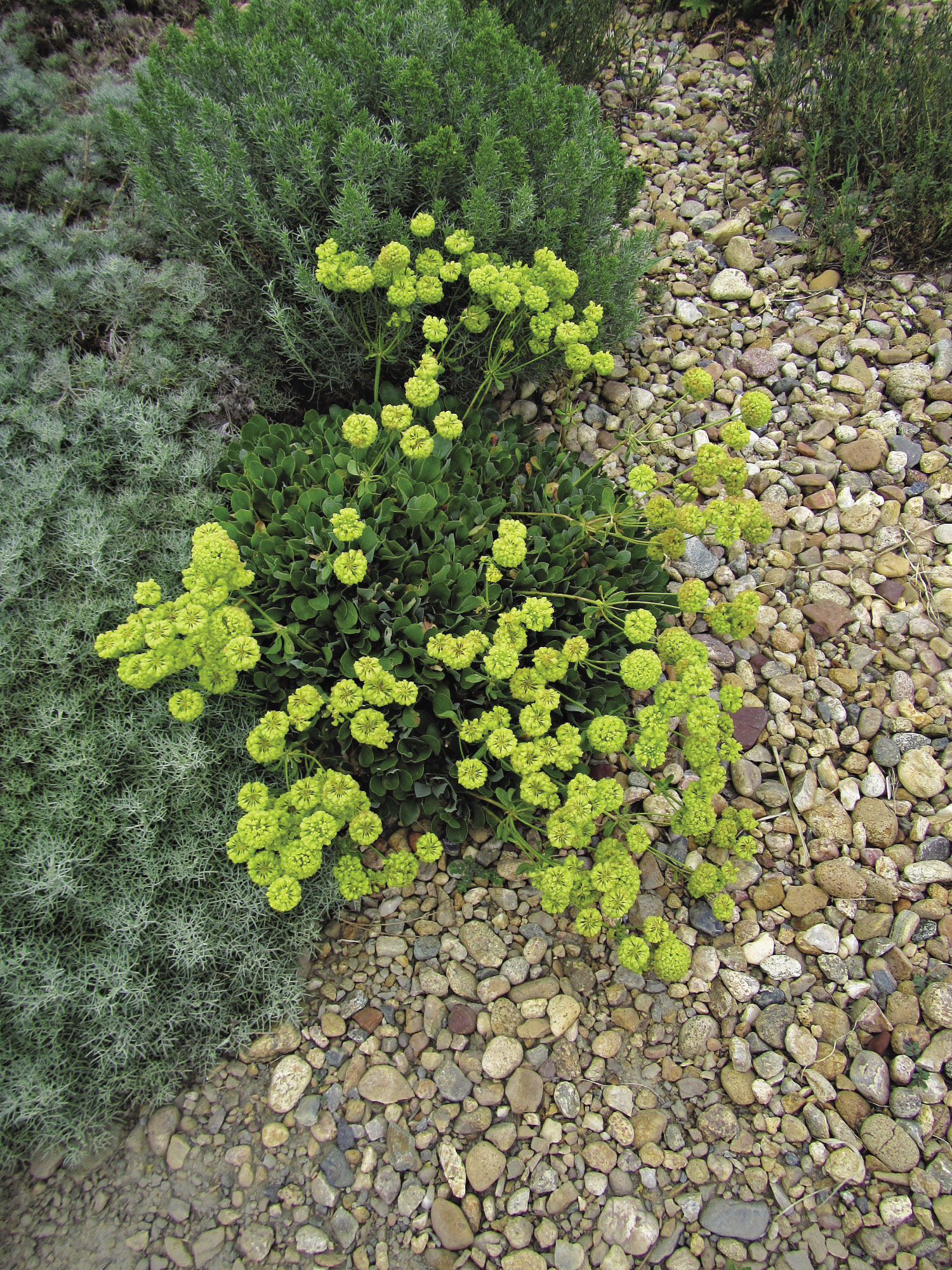
Kannah Creek® sulphur buckwheat should be mandatory for the water-wise garden, be that garden intentionally dry or simply neglected thanks to time-sucking pet videos on the internet. Introduced as part of the Plant Select program in Colorado, this variety is more floriferous, with larger flowers than is typical. From a low mat of green leaves (which turn purple-red in winter), stems carry clouds of yellow flowers that morph to orange and finally a burnt red-orange. Good drainage is key in a soil that’s low in organic components, so don’t kill it with kindness by forking in manure, mulching with compost, and irrigating. Instead, think lean and mean in the rock garden, hellstrip, or xeric landscape. And as if it needs to get better, deer don’t like it.
Zones: 3–8
Size: 12 to 16 inches tall and wide
Conditions: Full sun; well-drained soil
Tips for Keeping Things Fresh
“Evergreen” does not necessarily mean “no maintenance needed.” Just like rhodies and conifers, evergreen perennials occasionally need a haircut or help fighting off pests to stay looking their best for all 12 months.
Sometimes sun can enhance their color
Even though some evergreen perennials (e.g., bergenia) will grow in shade, their winter color is best when grown in at least half-day sun.
 |
 |
If it’s damaged, cut it out
When leaves are damaged by winter weather, cut the plant back as new growth begins or just before flowering.
Watch out for slugs and snails
Almost any plant with lush, succulent foliage (like many evergreen perennials) is a perfect slug and snail target. Hand-pick and dispose of these pests, or use baits to protect the plant foliage.
 |
 |
Avoid crown rot
Omnipresent leaves in winter can help harbor extra moisture and lead to crown rot (especially in plants like Kannah Creek® sulphur buckwheat). A gravel mulch can help keep the crowns drier.
Kelly Dodson and Sue Milliken own Far Reaches Farm, a specialty nursery in Port Townsend, Washington, where you’ll find many horticultural curiosities—some of which they may have found while leaning over a cliff edge in China.
Sources
Far Reaches Farm, Port Townsend, WA; 360-385-5114; farreachesfarm.com
High Country Gardens, Santa Fe, NM; 800-925-9387; highcountrygardens.com
Plant Delights Nursery; Raleigh, NC; 919-772-4794; plantdelights.com
Fine Gardening Recommended Products

Planting in a Post-Wild World: Designing Plant Communities for Resilient Landscapes
Fine Gardening receives a commission for items purchased through links on this site, including Amazon Associates and other affiliate advertising programs.
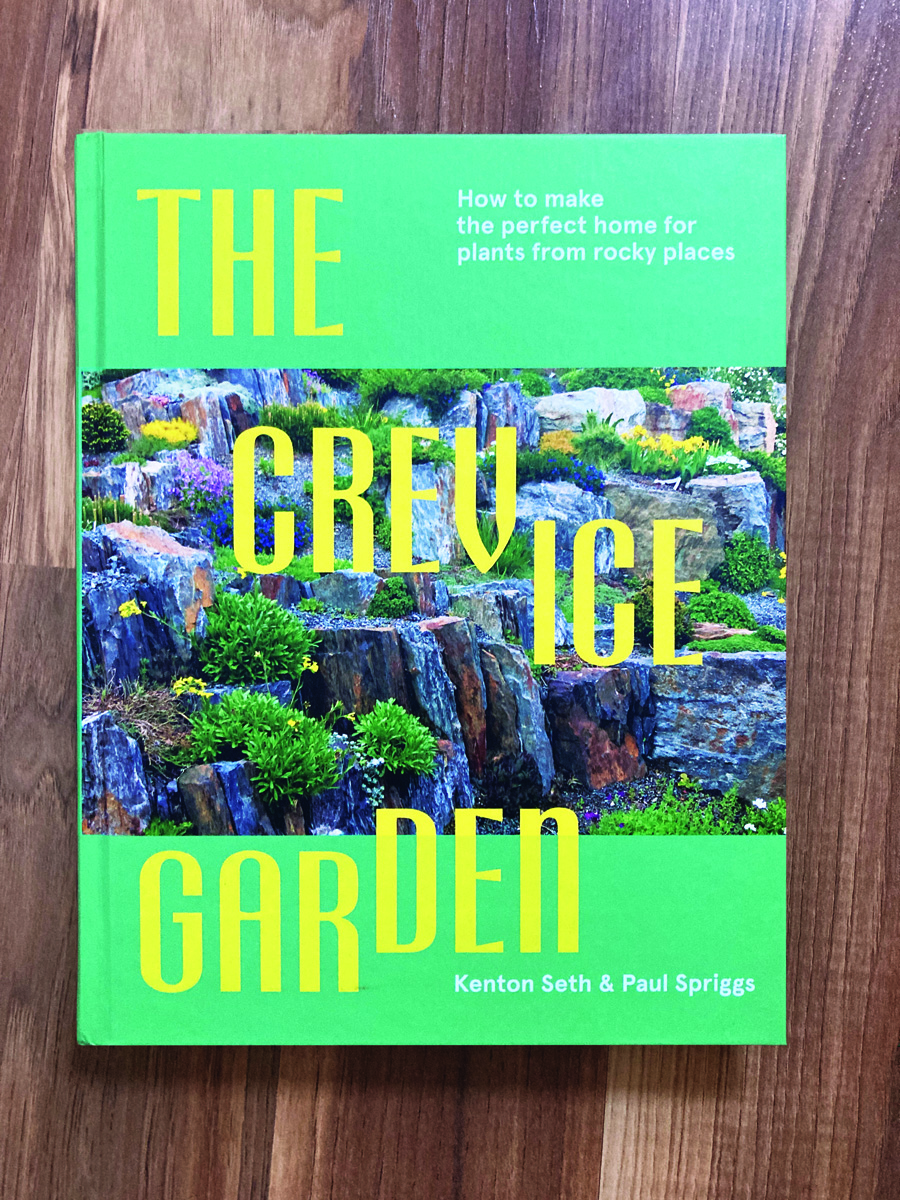
The Crevice Garden: How to make the perfect home for plants from rocky places
Fine Gardening receives a commission for items purchased through links on this site, including Amazon Associates and other affiliate advertising programs.

ARS Telescoping Long Reach Pruner
Fine Gardening receives a commission for items purchased through links on this site, including Amazon Associates and other affiliate advertising programs.

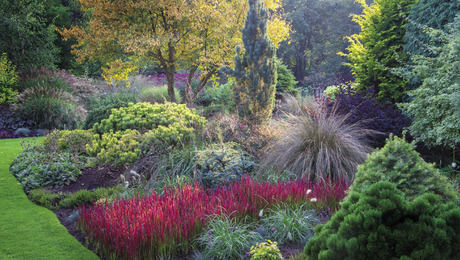
















Comments
Log in or create an account to post a comment.
Sign up Log in